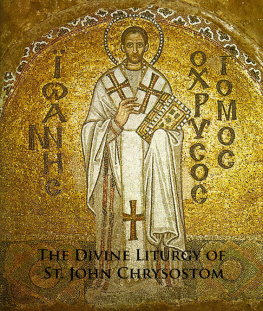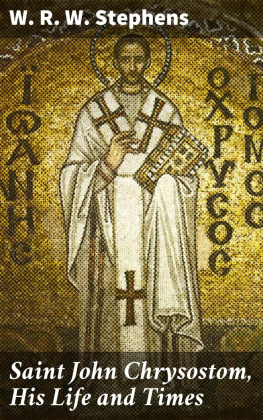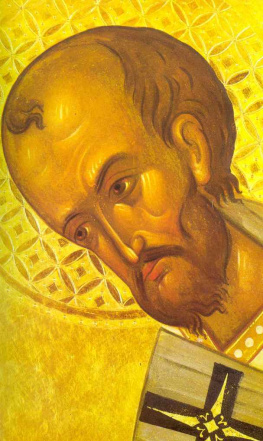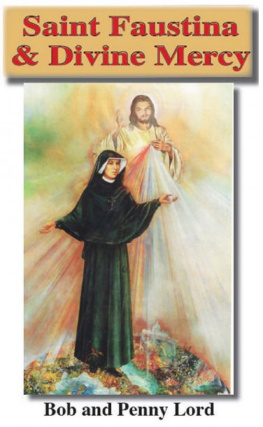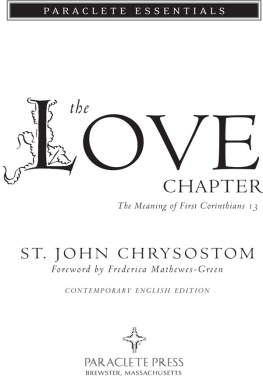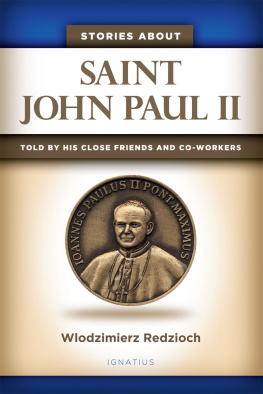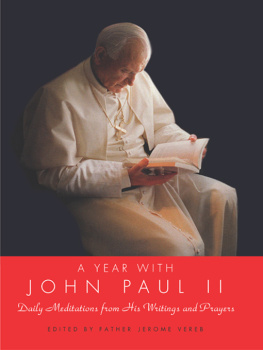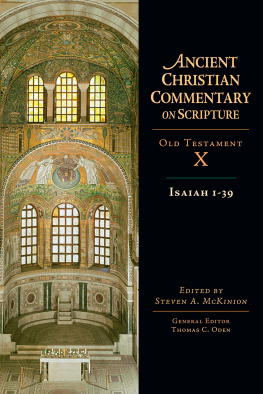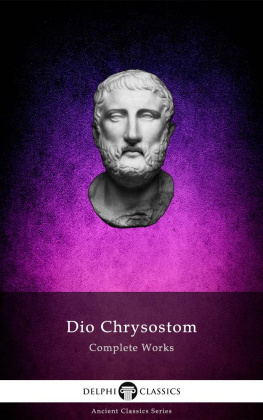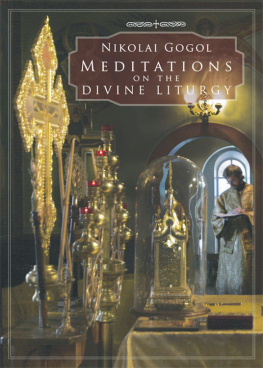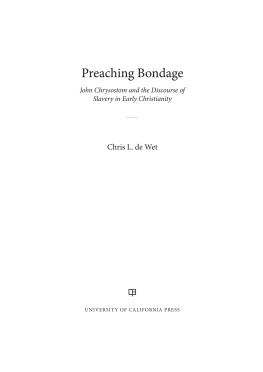John Chrysostom - The Divine liturgy of Saint John Chrysostom
Here you can read online John Chrysostom - The Divine liturgy of Saint John Chrysostom full text of the book (entire story) in english for free. Download pdf and epub, get meaning, cover and reviews about this ebook. City: New York, year: 1948, publisher: [The Alumni Association of the Russian Theological Seminary of North America], genre: Religion. Description of the work, (preface) as well as reviews are available. Best literature library LitArk.com created for fans of good reading and offers a wide selection of genres:
Romance novel
Science fiction
Adventure
Detective
Science
History
Home and family
Prose
Art
Politics
Computer
Non-fiction
Religion
Business
Children
Humor
Choose a favorite category and find really read worthwhile books. Enjoy immersion in the world of imagination, feel the emotions of the characters or learn something new for yourself, make an fascinating discovery.
- Book:The Divine liturgy of Saint John Chrysostom
- Author:
- Publisher:[The Alumni Association of the Russian Theological Seminary of North America]
- Genre:
- Year:1948
- City:New York
- Rating:4 / 5
- Favourites:Add to favourites
- Your mark:
- 80
- 1
- 2
- 3
- 4
- 5
The Divine liturgy of Saint John Chrysostom: summary, description and annotation
We offer to read an annotation, description, summary or preface (depends on what the author of the book "The Divine liturgy of Saint John Chrysostom" wrote himself). If you haven't found the necessary information about the book — write in the comments, we will try to find it.
The Divine liturgy of Saint John Chrysostom — read online for free the complete book (whole text) full work
Below is the text of the book, divided by pages. System saving the place of the last page read, allows you to conveniently read the book "The Divine liturgy of Saint John Chrysostom" online for free, without having to search again every time where you left off. Put a bookmark, and you can go to the page where you finished reading at any time.
Font size:
Interval:
Bookmark:
The Divine Liturgy of Saint John Chrysostom
John was born in Antioch in 349 toGreco-Syrian parents. Different scholars describe his mother Anthusa as a paganor as a Christian, and his father was a high ranking military officer. John'sfather died soon after his birth and he was raised by his mother.
He was baptised in 368 or 373 andtonsured as a reader (one of the minor orders of the Church). As a result ofhis mother's influential connections in the city, John began his educationunder the pagan teacher Libanius. From Libanius, John acquired the skills for acareer in rhetoric, as well as a love of the Greek language and literature.
As he grew older, however, hebecame more deeply committed to Christianity and went on to study theologyunder Diodore of Tarsus, founder of the re-constituted School of Antioch.According to the Christian historian Sozomen, Libanius was supposed to havesaid on his deathbed that John would have been his successor "if theChristians had not taken him from us".
He lived with extreme asceticismand became a hermit in about 375; he spent the next two years continuallystanding, scarcely sleeping, and committing the Bible to memory. As aconsequence of these practices, his stomach and kidneys were permanentlydamaged and poor health forced him to return to Antioch.
He was ordained as a deacon in 381by Saint Meletius of Antioch, and was ordained as a presbyter (that is, apriest) in 386 by Bishop Flavian I of Antioch. Over the course of twelve years,he gained popularity because of the eloquence of his public speaking,especially his insightful expositions of Bible passages and moral teaching. Themost valuable of his works from this period are his Homilies on various booksof the Bible. He emphasised charitable giving and was concerned with thespiritual and temporal needs of the poor. He also spoke out against abuse ofwealth and personal property.
Do you wish to honour the body ofChrist? Do not ignore him when he is naked. Do not pay him homage in the templeclad in silk, only then to neglect him outside where he is cold and ill-clad.He who said: "This is my body" is the same who said: "You saw mehungry and you gave me no food", and "Whatever you did to the leastof my brothers you did also to me"... What good is it if the Eucharistictable is overloaded with golden chalices when your brother is dying of hunger?Start by satisfying his hunger and then with what is left you may adorn thealtar as well.
His straightforward understandingof the Scriptures in contrast to the Alexandrian tendency towardsallegorical interpretation meant that the themes of his talks werepractical, explaining the Bible's application to everyday life. Suchstraightforward preaching helped Chrysostom to garner popular support. Hefounded a series of hospitals in Constantinople to care for the poor.
One incident that happened duringhis service in Antioch illustrates the influence of his sermons. WhenChrysostom arrived in Antioch, the bishop of the city had to intervene withEmperor Theodosius I on behalf of citizens who had gone on a rampage mutilatingstatues of the Emperor and his family. During the weeks of Lent in 387, Johnpreached twenty-one sermons in which he entreated the people to see the errorof their ways. These made a lasting impression on the general population of thecity: many pagans converted to Christianity as a result of the sermons. As aresult, Theodosius' vengeance was not as severe as it might have been.
A sculpture of John Chrysostom inSaint Patrick's Cathedral, New York City
In 398, John was requested, against his will, to take theposition of Archbishop of Constantinople. He deplored the fact that Imperialcourt protocol would now assign to him access to privileges greater than thehighest state officials.
During his time as Archbishop headamantly refused to host lavish social gatherings, which made him popular withthe common people, but unpopular with wealthy citizens and the clergy. Hisreforms of the clergy were also unpopular with these groups. He told visitingregional preachers to return to the churches they were meant to beservingwithout any payout.
His time in Constantinople was moretumultuous than his time in Antioch. Theophilus, the Patriarch of Alexandria,wanted to bring Constantinople under his sway and opposed John's appointment toConstantinople. Being an opponent of Origen's teachings, he accused John ofbeing too partial to the teachings of that theologian.
Theophilus had disciplined four Egyptian monks (known as"the tall brothers") over their support of Origen's teachings. Theyfled to and were welcomed by John. He made another enemy in Aelia Eudoxia, thewife of the eastern Emperor Arcadius, who assumed (perhaps with justification)that his denunciations of extravagance in feminine dress were aimed at herself.
Depending on one's outlook, Johnwas either tactless or fearless when denouncing offences in high places. Analliance was soon formed against him by Eudoxia, Theophilus and others of hisenemies. They held a synod in 403 (the Synod of the Oak) to charge John, inwhich his connection to Origen was used against him. It resulted in hisdeposition and banishment.
He was called back by Arcadiusalmost immediately, as the people became "tumultuous" over hisdeparture. There was also an earthquake the night of his arrest, which Eudoxiatook for a sign of God's anger, prompting her to ask Arcadius for John'sreinstatement.
Peace was short-lived. A silverstatue of Eudoxia was erected in the Augustaion, near his cathedral. Johndenounced the dedication ceremonies. He spoke against her in harsh terms:"Again Herodias raves; again she is troubled; she dances again; and againdesires to receive John's head in a charger," an allusion to the eventssurrounding the death of John the Baptist. Once again he was banished, thistime to the Caucasus in Armenia.
Pope Innocent I protested at thisbanishment, but to no avail. Innocent sent a delegation to intercede on behalfof John in 405. It was led by Gaudentius of Brescia; Gaudentius and hiscompanions, two bishops, encountered many difficulties and never reached theirgoal of entering Constantinople.
John wrote letters which still heldgreat influence in Constantinople. As a result of this, he was further exiledto Pitiunt (in modern Georgia) where his tomb is a shrine for pilgrims. Henever reached this destination, as he died during the journey. His last wordsare said to have been, " " (Glory be to God for all things).
John came to be venerated as asaint soon after his death. His disciple, Saint Proclus, Patriarch ofConstantinople (434-447), during services in the Church of Hagia Sophia,preached a sermon praising his teacher. He said, "O John, your life wasfilled with sorrow, but your death was glorious. Your grave is blessed andreward is great, by the grace and mercy of our Lord Jesus Christ O graced one,having conquered the bounds of time and place! Love has conquered space,unforgetting memory has annihilated the limits, and place does not hinder themiracles of the saint."
This sermon helped to mobilizepublic opinion, and the patriarch received permission from the emperor toreturn Chrysostom's relics to Constantinople, where they were enshrined in theChurch of the Holy Apostles.
The Eastern Orthodox Churchcommemorates him as a "Great Ecumenical Teacher", together with Basilthe Great and Gregory the Theologian. These three saints, in addition to havingtheir own individual commemorations throughout the year, are commemorated togetheron 30 January, a feast known as the Synaxis of the Three Hierarchs.
There are several feast days dedicated to him:
27 January, Translation of the relics of St John Chrysostomfrom Comana to Constantinople
30 January, Synaxis of the Three Great Hierarchs
14 September, Repose of St John Chrysostom
Next pageFont size:
Interval:
Bookmark:
Similar books «The Divine liturgy of Saint John Chrysostom»
Look at similar books to The Divine liturgy of Saint John Chrysostom. We have selected literature similar in name and meaning in the hope of providing readers with more options to find new, interesting, not yet read works.
Discussion, reviews of the book The Divine liturgy of Saint John Chrysostom and just readers' own opinions. Leave your comments, write what you think about the work, its meaning or the main characters. Specify what exactly you liked and what you didn't like, and why you think so.

